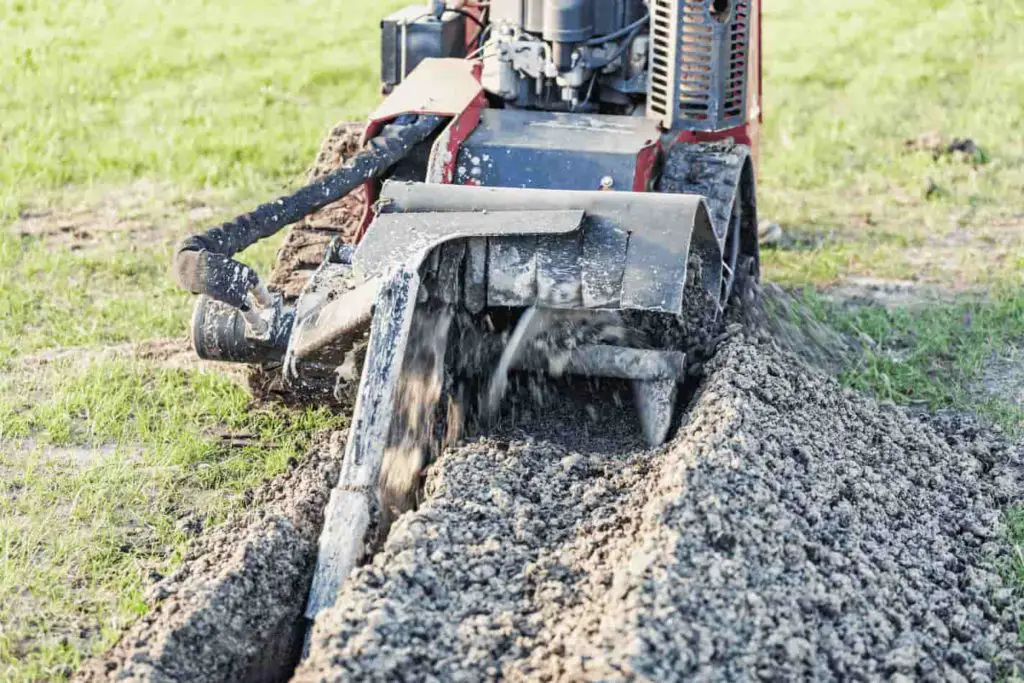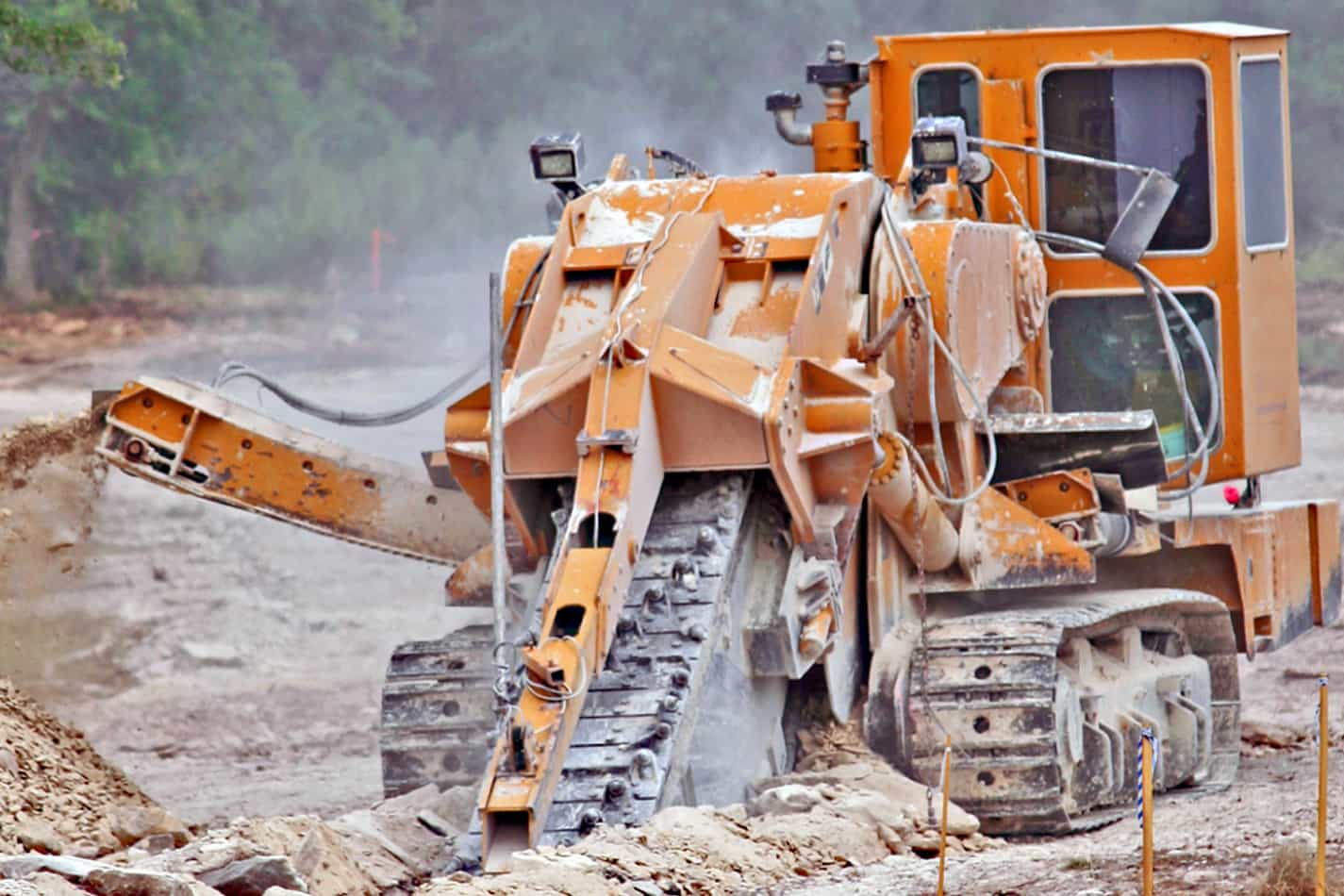Trenchers can assist landscape contractors with a wide range of duties. There are also walk-behinds, ride-on, and tools for your mower, skid steer, or tractor to select from in several sizes and types.
However, before selecting a trencher, you’ll need to consider factors such as the terrain type, space, depth and breadth of the trench you want to dig, budget, as well as how fast they move when active.
For many light urban, suburban, and commercial excavation operations, a walk-behind trencher is hard to match in terms of mobility, operator training, ease of use, and productivity.
Although walk-behind trenchers aren’t everyone’s favorite piece of equipment, they serve a crucial function for construction and inventory.
If you’re considering a walk-behind trencher for your operation, you probably want to know how fast they move when active. The short answer is a good walk-behind trencher should be able to trench at a rate of 1 – 1.75 feet per minute, depending on soil conditions.
Read on to learn more!

What are walk-behind trenchers?
Walk-behind trenchers are more labor-intensive since they are operated manually. They’re wonderful, though, when dealing with a limited area and want to do as little harm to your landscape as possible.
A walk-behind trencher is less powerful and ideal for digging shallow trenches of 2 to 3 feet deep or narrow. It’s simpler to utilize when dealing with limited space because it’s often smaller. Furthermore, walk-behind trenchers are more cost-effective and accessible.
Although less powerful and sturdy, walk-behind trenchers will cause less environmental disruption. However, this trencher will be too light if you want more horsepower to complete the task.
Look through our selection of Ditch Witch walk-behind trenchers.
What is the Speed of Digging with a Trencher Compared to a Walk Behind Trencher?
When considering trench digging time and speed, using a trencher compared to a walk-behind trencher can make a significant difference. A trencher, with its specialized design and powerful motor, is capable of digging trenches at a faster pace, reducing the overall time it takes to complete the task. The efficiency of a trencher allows for increased productivity and streamlined excavation processes.
How Fast Can Effective Line Digging be Achieved with a Trencher in a Smaller Machine?
Trenchers for efficient line digging make quick work of excavation tasks, even in smaller machines. These powerful tools can achieve fast and effective digging, allowing for the installation of utilities, irrigation systems, or any project requiring a trench. With their specialized design and capabilities, trenchers provide a reliable solution for achieving efficient line digging in various applications.
How fast will a walk-behind trencher dig?
As stated earlier, a decent walk-behind trencher can dig somewhere between 1- 1.75 feet every minute, depending largely on the soil conditions.
Notwithstanding, some manufacturers claim to offer trenching versions that are even quicker. Whatever the case, it’s essential to recognize that the depth of the trench is undoubtedly significant.
Still, speed is simply one component of productivity. Contractors also want a trencher that can withstand much use while still being simple to maintain and service.
Which walk-behind trencher is suitable for doing jobs around my yard?
The smallest walk-behind trencher has a maximum cut depth of 12 inches and cuts 3 inches wide, making it ideal for little chores around the yard. This machine is entirely manual and has a pull start.
It features three adjustable notches with depths of 4″, 8″, and 12″. A little kicker on the rear pulls the machine backward as you cut.
We also have considerably larger trenchers available at Ralphs for any major projects you may have.
What should I consider when looking for a walk-behind trencher?
To select the perfect walk-behind trencher for your operation, you should consider the following;
What are you planning to do with it?
As a landscape contractor, you must, first and foremost, consider what you intend to do with the trencher.
Low-voltage wiring for landscape lighting, irrigation system installation, edging, and fence are typical walk-behind trenchers applications.
Another use for a walk-behind trencher is tree root trimming, which has recently gained traction. Some contractors employ a walk-behind trencher to cut down roots that have grown up adjacent to a sidewalk or driveway.
Trenching width and depth
Also, trenching width and depth are crucial factors when renting or purchasing a walk-behind trencher. For example, if you’re trenching for landscape lighting, you might need an inch-wide trench 6-8 inches deep.
If installing an irrigation system, you’ll probably need to dig a trench 8 inches deep in the south and 12 inches deep in the north.
Soil type
Another factor to consider is the type of surface/soil. Your walk-behind trencher must be capable of operating under the conditions you’ll encounter.
How simple is it to use?
As a landscape contractor, you may want to use your walk-behind trencher for various jobs (as indicated above). For this reason, you’d want to learn how simple it is to modify trenching depth.
Adapting to a range of trenching depths swiftly can be pretty beneficial. The same may be said for trenching width. Examine how difficult it will be to modify trenching width by changing blades or cutting teeth before renting or hiring a walk-behind trencher.
Consider if you want to pull or push. Because the blade turns clockwise, certain trenchers must be pulled.
Some trenchers are self-propelled, which makes them easier to operate. If you aren’t sure, you may want to pay special attention to the tires. The trencher will be easier to maneuver with pneumatic tires.
Again, the turning radius is a significant issue if you plan to do more than dig in a straight line.
Another item to consider is the cleanup when the service is completed. Some trenchers are built to deposit dirt perfectly beside the trench.
Check if the trencher can withstand tough or repeated use?
Besides the depth of digging and speed, as essential walk-behind trenchers’ productivity components, contractors also want a trencher that can withstand a lot of use while still being simple to maintain and service.
Typically, a powder-coat finish will extend the machine’s life by preventing corrosion.
You want to check whether the trencher you’re considering has any built-in measures to prevent it from harm if it is an impediment.
Furthermore, the ease of upkeep is another something to consider. Ensure that you check to see if the cutting teeth can be easily replaced. Some brands have teeth incorporated straight into the cutting wheel.
Check the machine’s safety and support.
Finally, as with any piece of power equipment, learn about the trencher’s many safety measures.
Ensure you’re purchasing from a reputable repair center that will give you parts and service when needed.
Also, don’t overlook the possibility of renting. If you only plan on using a trencher a few times a year, renting is a good option. But buying it is probably the best option if you believe you’ll use it for at least a couple of weeks.
Thanks for reading to the end. We hope you learned!



